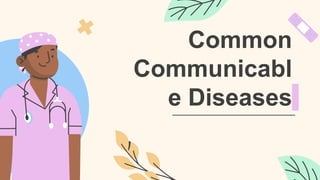
HEALTH COT 1 GRADE 8 MARCH 22, 2023.pptx
- 2. Communicable diseases ● also known as infectious diseases or transmissible diseases, are illnesses that result from the infection, presence and growth of pathogenic (capable of causing disease) biologic agents in an individual human or other animal host.
- 4. Acute Respiratory Infections ● infections in the upper or lower respiratory tract that prevents normal breathing.
- 5. Pneumonia is a lung infection where air sac or alveoli are filled with pus or fluid that limits oxygen intake.
- 6. Infectious Agents • Bacteria • Viruses • Fungi Pneumonia can be spread in several ways. The viruses and bacteria that are commonly found in a child's nose or throat can infect the lungs if they are inhaled. They may also spread via air-borne droplets from a cough or sneeze.
- 7. Signs/Symptoms • Chills, high fever, pleuritic chest pain, cough, crackles, and wheezes.
- 9. Treatment • Antibiotics • Hospitalization for severe cases
- 10. Bronchitis is the inflammation of the bronchial tubes-e air passages between the nose and lungs.
- 11. Infectious Agents • Viruses • Bacteria • Irritant particles Acute bronchitis due to infection is often transmitted through microscopic, airborne droplets that contain a germ and are produced when someone speaks, sneezes, or coughs. It can also be transmitted by shaking hands or other types of physical contact with a person who has the
- 12. Signs/Symptoms • Persistent coughing, wheezing, chest discomfort, low fever, chills, sore throat, body aches, congested nose
- 14. Treatment • Rest • Fluids • Breathe warm and moist air • cough and pain medication • Antibiotics
- 15. Tuberculosis an infectious bacterial disease affecting the lungs.
- 16. Infectious Agent • Mycobacterium tuberculosis It's spread when a person with active TB disease in their lungs coughs or sneezes and someone else inhales the expelled droplets, which contain TB bacteria.
- 17. Signs/Symptoms • Cough, chest pain, breathlessness, night sweats, weight loss, weakness, and fatigue
- 19. Treatment • 6-month course of antibiotics.
- 20. Dengue a mosquito-borne disease occurring in the tropics.
- 21. Infectious Agent • Dengue virus The dengue virus is primarily transmitted from person to person through the bite of an infected Aedes aegypti or Aedes albopictus mosquito.
- 22. Signs/Symptoms • Fever, muscle and joint pains, pain behind eyes, rash, nausea and vomiting, minor bleeding from gums and nose.
- 24. Treatment • Rest • Fluids • Breathe warm and moist air • cough and pain
- 25. STIs or Sexually Transmitted Diseases an infection through unprotected sexual contact.
- 26. HIV/AIDS is a chronic life- threatening condition caused by the human immunodeficiency virus.
- 29. Signs/Symptoms • fever, night sweat. weight loss, headache, enlarged lymph nodes, diarrhea, vomiting, upset stomach, genital sores, dry cough, rash, short term memory
- 30. Treatment • No treatment but there are medications that slow down the progress of the disease
- 31. Several ways that you must follow and practice to prevent you from acquiring diseases.
- 32. WASH CAMP
- 33. W - wash your hand regularly A - avoid sharing personal belonging S - stay and rest at home when sick H - handle and prepare foods
- 34. C - cover your mouth when you cough or sneeze A - avoid touching animal that could bring disease M - make sure you get vaccinated P - properly disinfect and clean surfaces like toilet bowls, sinks, etc.
- 35. Acting Skit Create a short skit regarding on how to prevent having communicable diseases.
- 36. Category 3 2 1 Presentation – Students give dramatic presentations Lines are memorized and presented dramatically. Lines are mostly memorized with some dramatic presentation. Lines are not memorized, thus lacking dramatic presentation Listening – Student displays appropriate turn-taking behaviors While others are performing, student is actively listening. While others are performing, student listens but has to be prompted 2-3 times to pay attention While others are performing, student is working on something else or has to e prompted more than 3 times to pay attention. Preparedness – Organizes information to achieve a purpose Student organizes information in a way that completely prepares them for presentation Student is somewhat organized ad prepared Student is not at all prepared and organized
- 37. Assignment Research and list the down the pathogens that causes disease to human and other living organisms.
- 38. “I believe that the greatest gift you can give your family and the world is a healthy you.” – Joyce Meyer